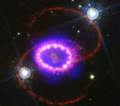Conveners
What we can learn from SN spectra and light curves: M. Modjaz, "Stripped core collapse supernovae"
- There are no conveners in this block
What we can learn from SN spectra and light curves: M. Stritzinger, "Carnegie Supernova Project Observations of Stripped Core-Collapse Supernovae"
- There are no conveners in this block
What we can learn from SN spectra and light curves: N. Chugai, "Type IIn supernovae"
- There are no conveners in this block
What we can learn from SN spectra and light curves: O. Fox, "Dust in core-collapse supernovae"
- There are no conveners in this block
What we can learn from SN spectra and light curves: I. Cherchneff, "Theory of dust formation in core-collapse supernovae"
- There are no conveners in this block
What we can learn from SN spectra and light curves: O. Krause, "Light echoes of core collapse supernovae"
- There are no conveners in this block
What we can learn from SN spectra and light curves: L. Dessart, "Spectroscopic Modeling of Core-Collapse Supernovae"
- There are no conveners in this block
What we can learn from SN spectra and light curves
- Brian Schmidt (MSO, Australian National Univ.)
Dr
Maryam Modjaz
(Columbia University)
11/08/2011, 13:30
Stripped-envelope core-collapse supernovae (i.e., SNe of Type IIb, Ib,
Ic and broad-lined Ic) are supernovae whose massive
progenitors have been stripped of progressively larger amounts of
their hydrogen and helium envelopes. While the SNe Ic-bl associated
with long Gamma Ray Bursts (GRBs) have been studied in detail, the
full range of properties of normal or broad-lined SNe is not...
Mrs
Maximilian Stritzinger
(Stockholm University)
11/08/2011, 14:00
The Carnegie Supernova Project obtained detailed optical (uBgVri) and near-IR (YJHKs)
light curves of 35 Type Ib/c and Type IIb supernova. This data set is particularly
well-suited to explore color relations over a broad wavelength range, and may offer
new ways to accurately estimate host galaxy extinction. I will present the
photometric sample and results from an initial analysis of the...
Dr
Nikolai Chugai
(Institute of astronomy, Russian. Ac. Sci.)
11/08/2011, 14:30
Type IIn supernovae (SN IIn) is highly diverse and badly understood class with a
common feature: they show narrow emission lines indicative of a dense circumstellar
matter (CSM). The narrow emission lines could originate either from the undisturbed
circumstellar gas excited by
X-ray/ultraviolet radiation or from shocked circumstellar clouds. In most SNe IIn the
total luminosity is fully...
Dr
Ori Fox
(NASA/GSFC/ORAU)
11/08/2011, 15:30
A relatively small number of CCSNe have been observed to exhibit late-time (>100
d) infrared emission from dust over the past 30 years. Since the launch of Spitzer
(and now even Herschel), the community has had the capability to probe supernova-
associated dust at mid- and far-infrared wavelengths. Combined with ground-based
optical and NIR observations, these data have provided...
Dr
Isabelle Cherchneff
(Universitaet Basel)
11/08/2011, 16:00
Cosmic dust forms in the circumstellar environments of evolved stars with low and
high masses because the synthesis of dust requires high gas densities and
temperatures. Supernovae are one of these environments and form dust in their ejecta
a few months after their explosion. The harsh physical conditions met in the ejecta
and the absence of hydrogen hamper the production of complex...
Dr
Oliver Krause
(Max Planck Institute for Astronomy)
11/08/2011, 16:30
Young Galactic supernova remnants are unique laboratories for supernova physics. Due
to their proximity they provide us with the most detailed view of the outcome of a
supernova. However, the exact spectroscopic types of their original explosions have
been undetermined so far - hindering to link the wealth of multi-wavelength knowledge
about their remnants with the diverse population of...
Dr
Luc Dessart
(Laboratoire d'Astrophysique de Marseille)
11/08/2011, 17:00
I will present a new modeling approach that simultaneously computes spectra and
light curves and takes into account line blanketing, departures from Local
Thermodynamic Equilibrium, time dependent terms in the radiative-transfer, energy,
and statistical-equilibrium equations, as well as non-thermal processes associated
with radioactive decay. Combined with hydrodynamical inputs of SN...

